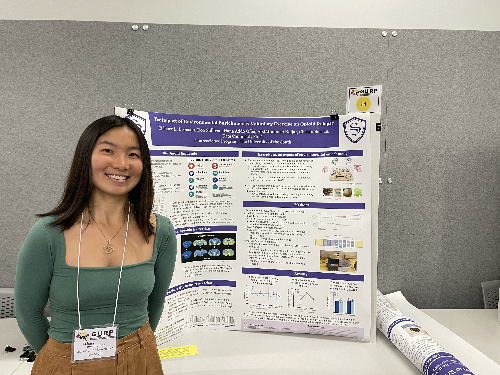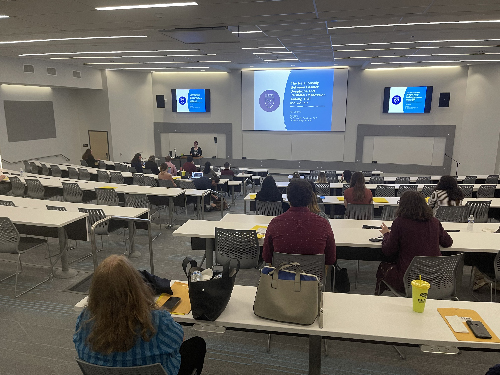Presentation Types
Students planning to submit conference proposals to GURP will be asked to rank their
preferences for a Poster Presentation, an Oral Presentation, or a Flash Talk. Your rankings should be agreed upon with your research mentor and (if applicable)
co-authors.
If your abstract is accepted, then your acceptance email will also include the presentation
type. Decisions about presentation types will be based on the quality of the abstract
and stage of the research project. Details about the three presentation types are
provided below.
Poster Presentations
 A poster presentation is a great opportunity to showcase your research visually. In
this format, you will create a large poster that summarizes your project, usually
including the introduction, methods, results, and conclusions. Rather than presenting
your research one time to a large audience, you will have the opportunity to stay
near your poster for a whole poster session. During the poster session, you will have
the chance to talk about your research in small groups, answer questions, and receive
feedback in a more personal setting. This allows you to engage in interactive discussions
with conference attendees who stop by your poster.
A poster presentation is a great opportunity to showcase your research visually. In
this format, you will create a large poster that summarizes your project, usually
including the introduction, methods, results, and conclusions. Rather than presenting
your research one time to a large audience, you will have the opportunity to stay
near your poster for a whole poster session. During the poster session, you will have
the chance to talk about your research in small groups, answer questions, and receive
feedback in a more personal setting. This allows you to engage in interactive discussions
with conference attendees who stop by your poster.
-
Should I select the poster presentation format?
Poster presentations are ideal for research that is in progress or where a visual representation of data is particularly effective. This format can also be beneficial if you prefer a more relaxed, conversational approach to presenting your findings. Poster sessions are also helpful when you want to get feedback on your research or have more opportunity to network. If your goal is to gather insights, suggestions, and connect with other researchers and professionals, a poster presentation can be beneficial.
-
What is a poster session?A poster session is a designated time during the conference when only poster presentations are displayed. Poster sessions take place in a large room where each presenter is assigned a specific space to display their poster. During poster sessions, attendees can move around to view different posters and engage in discussions with presenters while presenters stay near their own posters. GURP poster sessions will be 1 hour long.
-
How can I prepare for a poster session?
First, you will need to create your poster; this is often done in PowerPoint. Posters should be designed as a single 36”H x 48”W. If this is your first time designing a poster, be sure to check out resources like this video by the KSU Office of Undergraduate Research and ask your research mentor for help. You will also need to have your poster printed in time for the conference. Be sure to send your poster to be printed a week (or more) in advance. Talk to your research mentor about the best options for printing your poster.
Second, you will need to prepare your presentation. Although your poster itself should be relatively self-explanatory, the benefit of a poster session is the opportunity to engage with others. Be prepared to welcome each person who comes to your poster and explain your research in no more than 2 to 3 minutes. Remember that attendees may not be familiar with your research topic, so practice your presentation with people outside of your research lab or co-authors. This also means that they might have questions, so you will need to be prepared to answer questions and share more details about certain aspects of your poster, like the measures you used, the analyses you completed, your findings, and what your findings mean.
Finally, during the conference, plan to arrive early to the poster session so you are ready when attendees arrive. Hang your poster in its designated spot; each spot will be labeled with a number that corresponds to your poster number in the program and in your acceptance email. Make friends with your poster neighbors by introducing yourself and helping each other hang your posters. You or your co-authors should remain by the poster for the duration of the poster session. -
Where can I find good examples and suggestions for posters?
In addition to the links below, ask your research mentor for examples of posters they or their other students have presented. They might even have a template that you can use as a starting place for your own poster!
Flash Talks and Oral Presentations
 Flash talks and oral presentations are fantastic opportunities to present your research
to a larger audience. Sometimes people refer to these types of presentations as “paper
presentations” or “talks.” The oral presentation format is ideal for original, empirical
research that is more developed and ready to be presented in a structured, formal
setting. Flash talk presentations are similar but, as suggested in their name, are
a bit shorter than typical oral presentations. Unlike poster presentations, flash
talks and oral presentations allow you to share your research with everyone in the
room at once. These formats allow you to engage with a wider audience and can be a
great way to enhance your public speaking skills and gain visibility for your research.
During your presentation, you will have the chance to explain your work in detail,
highlight the importance of your findings, and discuss the broader implications of
your research.
Flash talks and oral presentations are fantastic opportunities to present your research
to a larger audience. Sometimes people refer to these types of presentations as “paper
presentations” or “talks.” The oral presentation format is ideal for original, empirical
research that is more developed and ready to be presented in a structured, formal
setting. Flash talk presentations are similar but, as suggested in their name, are
a bit shorter than typical oral presentations. Unlike poster presentations, flash
talks and oral presentations allow you to share your research with everyone in the
room at once. These formats allow you to engage with a wider audience and can be a
great way to enhance your public speaking skills and gain visibility for your research.
During your presentation, you will have the chance to explain your work in detail,
highlight the importance of your findings, and discuss the broader implications of
your research.
-
Which presentation type should I select?We encourage you to submit your presentation in the type that you and your research mentor think best fit the content and stage of your research. For example, research that is in progress or is limited to a small pilot are better fit for poster presentations or flash talks, while completed research with more robust findings are better fit for oral presentation.
-
How can I prepare for an oral presentation or flash talk?
Prior to the conference, you will prepare a slide deck that describes your project, typically including information from each section of a traditional research paper: introduction, methods, results, and conclusions. Preparing for an oral presentation or flash talk involves creating clear, concise slides. Presentation slides are usually best when they are engaging and have fewer words (i.e., not packed with lots of text); remember, the purpose of the slides is to be a visual complement to what you’re saying – the slides do not need to stand alone. If this is your first time preparing for an oral presentation or flash talk, check out resources like this video from the KSU Office of Undergraduate Research and get feedback from your faculty mentor.
It is important to practice your presentation to ensure a polished delivery and to limit yourself to the allotted time (15 minutes for oral presentations; 5 minutes for flash talks). You will also need to be ready to answer questions from the audience, which can provide valuable feedback and spark further discussion.
During the conference, you will deliver your presentation at the place and time you are scheduled (noted in the conference program). All presenters in a session should arrive early to load their presentation slides on the computer in the presentation room before the first presentation begins. You are encouraged to save your slides in a few locations (e.g., a USB drive; Dropbox; Google Drive; email) and in both PPT and PDF formats to limit the possibility for technical difficulties. -
How will oral presentation sessions be structured?Each oral presentation session will be 60 minutes long and include 3 presentations. When possible, presentations will be grouped with other similar presentations. All presenters in a session should arrive to the presentation room early to load their presentation slides before the first presentation begins. Each oral presentation session will have a discussant. The role of the discussant is to listen to each presentation and spark conversation that relates to all of the presentations. Each presenter is allotted 15 minutes for their presentation, followed by 5 minutes for Q&A specific to their presentation while the next presenter gets ready. Once all of the presentations are over, there will be another 15 minutes for discussion lead by the discussant. At GURP, the discussant will also “chair” the session, meaning they will help each presenter get set up, introduce the speakers to the audience, and keep time for the presenters.
-
How will flash talk sessions be structured?Each flash talk session will be 45 minutes long and include between 6 and 8 presentations. When possible, presentations will be grouped with other similar presentations. All presenters in a session should arrive to the presentation room early to load their presentation slides before the first presentation begins. Each flash talk session will have a discussant. The role of the discussant is to listen to each presentation and spark conversation that relates to all of the presentations. Each presenter is allotted 5 minutes for their presentation, followed by a few questions specific to their presentation while the next presenter gets ready. Once all of the presentations are over, there will be another 10 minutes for discussion lead by the discussant. At GURP, the discussant will also “chair” the session, meaning they will help each presenter get set up, introduce the speakers to the audience, and keep time for the presenters.
-
How can I make sure my presentation stays within the allotted time?It is important to practice your presentation to ensure a polished delivery. This includes timing yourself to ensure you stay within the allotted time. This is both a matter of respect and logistics. When a presenter goes over their allotted time, another presenter loses time and potentially leads to deviations from the conference schedule. Therefore, the discussant will keep time for each presentation and give 5-minute and 1-minute warnings. The time limit will be strictly enforced.
-
How do I choose the right presentation type for my research?We encourage you to select the presentation type that best fits your research. All presentation types require the same submission information. During your submission, we will ask you to rank your preferences of presentation types. We encourage you to discussion the presentation type with your faculty mentor. To best balance the types of presentations across the conference, we will take into account both your preferences and the information you provide in your abstract when we determine the presentation type to accept. Ranking your preferred presentation type will also help us to provide as many opportunities for presenting as possible despite the conference being only one day. Your presentation type will be made clear in the email communication notifying you of your submission status (no later than February 21, 2025).











